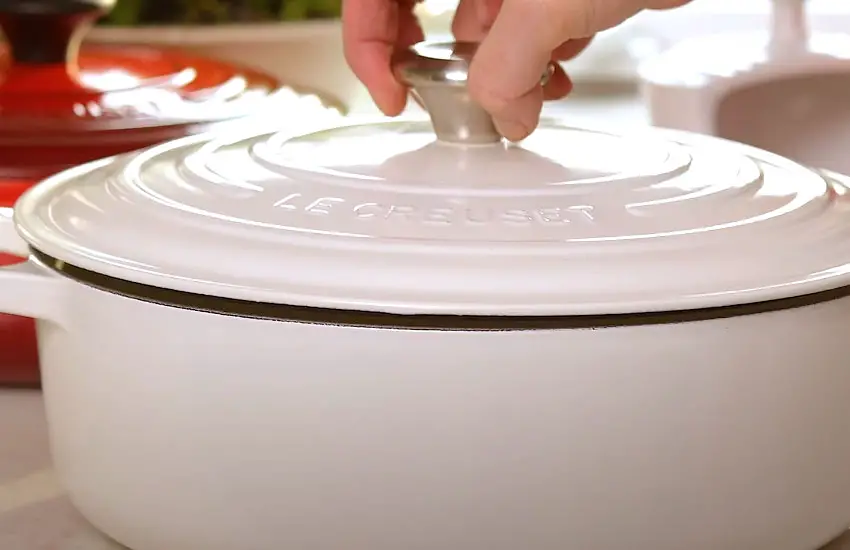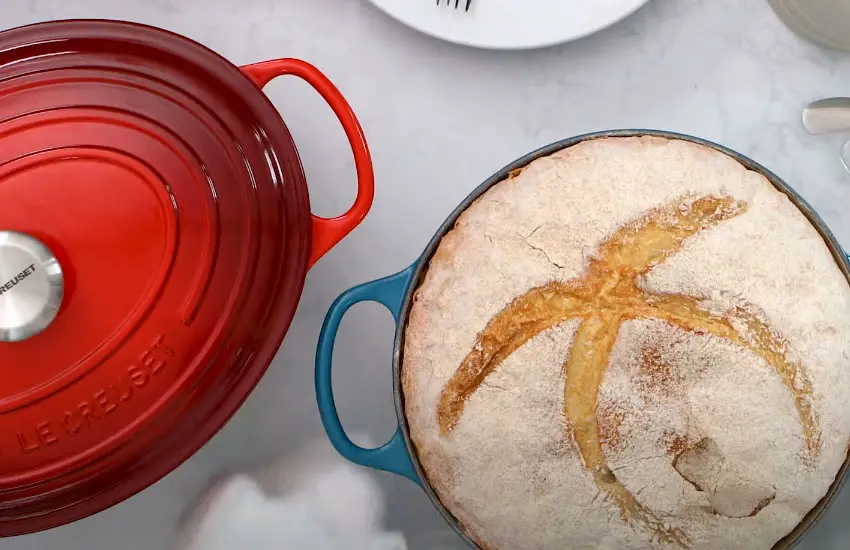As an Amazon Associate, I earn from qualifying purchases at no extra cost to you.
Easy Steps to Remove Stains from Your Enamel Dutch Oven
Enamel Dutch ovens are fantastic for cooking all sorts of delicious meals, but sometimes, stains can happen. These stains might make your Dutch oven look less pretty, but don’t worry! With a little know-how and some easy cleaning techniques, you can keep your Dutch oven looking as good as new.
In this guide, we’ll walk you through the process of removing stains from your enamel Dutch oven step by step. Whether you’re dealing with burnt-on food, oil residue, or sauce spills, we’ve got you covered. Let’s dive in and learn how to make your enamel Dutch oven shine again!

Understanding Enamel Dutch Ovens
Enamel Dutch ovens are special pots used for cooking. They are made of metal and covered with a layer of enamel. This enamel is like a tough, colorful coating that protects the metal underneath. It also makes the pot pretty and easy to clean.
These pots are great for cooking many different things. You can use them to make soups, stews, roasts, and even bread! The enamel helps distribute heat evenly, so your food cooks nicely.
But sometimes, when we cook, stains can happen. Stains are spots or marks that stick to the enamel and make the pot look dirty. They can happen when food burns or when sauces spill over. Stains can be annoying, but they’re not too hard to fix!
To understand stains on enamel Dutch ovens, think about when you accidentally spill something on your favorite shirt. Just like you need to clean your shirt to remove the stain, you also need to clean your Dutch oven.
Enamel Dutch ovens can get stains from all sorts of foods. Tomato sauces, spices, and oils can leave marks. But don’t worry! With a little bit of cleaning, you can make your Dutch oven look good as new.
The key is to be gentle when cleaning. Harsh scrubbing or using abrasive cleaners can scratch the enamel. Instead, use mild soap, baking soda, and vinegar. These gentle cleaners can help lift stains without damaging the pot.
Taking care of your enamel Dutch oven is important to keep it looking nice and working well. With the right care, your Dutch oven can last for many delicious meals to come!
Common Types of Stains on Enamel Dutch Ovens
Enamel Dutch ovens are fantastic for cooking tasty meals, but sometimes, stains can happen. These stains are like little marks or spots that stick to the enamel surface of the pot. They can make your Dutch oven look less pretty and clean, but don’t worry! Let’s talk about some common types of stains and how to deal with them.
- Burnt Food Stains: One of the most common types of stains on enamel Dutch ovens happens when food burns. Maybe you left your stew on the stove for too long, or perhaps your bread got a bit too crispy. When food burns, it can leave dark, stubborn stains on the enamel surface. But fear not! You can still rescue your Dutch oven.
- Oil Residue: Cooking with oils and fats is common, but sometimes, they can leave behind greasy stains on your enamel Dutch oven. These stains may appear as oily spots or streaks on the surface.
- Sauce and Spill Stains: Accidents happen in the kitchen, and sometimes, sauces or liquids can spill onto your Dutch oven. These stains can range from light splatters to dark, concentrated spots.
- Discoloration: Over time, the enamel surface of your Dutch oven may develop discoloration, appearing as faded patches or color changes.
By understanding the common types of stains on enamel Dutch ovens and knowing how to address them, you can keep your cookware looking clean, beautiful, and ready to cook up delicious meals!
Step-by-Step Guide to Removing Stains

Step 1: Gather Your Materials
Before you start cleaning, make sure you have everything you need. Here’s what you’ll need:
- Mild dish soap or detergent
- Baking soda
- White vinegar
- Soft sponge or cloth
- Water
Step 2: Precautions
Always remember to handle your enamel Dutch oven with care. Here are some precautions to keep in mind:
- Let the Dutch oven cool down completely before cleaning to avoid burns.
- Avoid using harsh scrubbers or abrasive cleaners, as they can scratch the enamel surface.
- Be gentle when scrubbing to prevent damage to the enamel.
Step 3: Soak the Stained Area
Start by filling your sink or a basin with warm water and adding a few drops of mild dish soap or detergent. Submerge the stained area of the Dutch oven in the soapy water and let it soak for about 15-30 minutes. This will help loosen the stains and make them easier to remove.
Step 4: Create a Baking Soda Paste
While the stained area is soaking, prepare a baking soda paste. Simply mix a small amount of baking soda with water to form a thick paste. Baking soda is a gentle abrasive that can help lift stains without scratching the enamel surface.
Step 5: Apply the Baking Soda Paste
Once you’ve made the baking soda paste, apply it directly to the stained areas of the Dutch oven. Use a soft sponge or cloth to gently spread the paste over the stains, making sure to cover them completely. Let the paste sit on the stains for about 10-15 minutes to allow it to work its magic.
Step 6: Scrub Gently
After the baking soda paste has had time to work, use a soft sponge or cloth to gently scrub the stained areas of the Dutch oven. Use circular motions and apply light pressure to avoid scratching the enamel surface. You may need to scrub for a few minutes to completely remove the stains.
Step 7: Use Vinegar for Stubborn Stains
If you’re dealing with particularly stubborn stains that won’t come off with baking soda alone, you can use white vinegar to help. Simply pour a small amount of white vinegar directly onto the stained areas of the Dutch oven. The acidity of the vinegar will help break down the stains and make them easier to remove.
Step 8: Rinse and Dry
Once you’ve finished scrubbing, rinse the Dutch oven thoroughly with warm water to remove any remaining baking soda or vinegar residue. Make sure to rinse it well to avoid leaving any residue behind. Once the Dutch oven is clean, dry it thoroughly with a clean towel or cloth.
Step 9: Repeat if Necessary
If the stains are still visible after the first round of cleaning, don’t worry! You can repeat the process as many times as necessary until the stains are completely gone. Just be patient and persistent, and eventually, your Dutch oven will be sparkling clean again.
Step 10: Maintenance and Prevention
To keep your enamel Dutch oven looking clean and stain-free, it’s important to practice regular maintenance and prevention. Here are a few tips to help:
- Clean your Dutch oven after each use to prevent stains from building up.
- Avoid cooking highly acidic or strongly colored foods for prolonged periods in your Dutch oven, as they can cause discoloration.
- Store your Dutch oven in a dry place to prevent moisture-related stains.
- Consider seasoning your Dutch oven regularly to maintain its appearance and protective coating.
By following these simple steps and tips, you can easily remove stains from your enamel Dutch oven and keep it looking clean and beautiful for years to come!
Additional Tips for Stain Prevention and Maintenance
Here are some easy-to-understand tips for preventing stains and maintaining your enamel Dutch oven:
Season Your Dutch Oven Regularly
Just like cast iron cookware, enamel Dutch ovens can benefit from seasoning. Seasoning creates a protective layer on the enamel surface, making it more resistant to stains and sticking. To season your Dutch oven, simply rub a thin layer of oil (such as vegetable or flaxseed oil) all over the interior surface, including the lid if it’s enamel-coated. Then, place the Dutch oven in a preheated oven at 300°F (150°C) for about an hour. Let it cool completely before using or storing.
Avoid Using Metal Utensils
Metal utensils can scratch the enamel surface of your Dutch oven, making it more prone to stains and damage. Instead, opt for wooden, silicone, or nylon utensils, which are gentler on the enamel. These utensils will help preserve the integrity of the enamel surface and keep your Dutch oven looking new for longer.
Promptly Clean Spills and Stains
Accidents happen in the kitchen, but cleaning up spills and stains promptly can help prevent them from becoming stubborn and difficult to remove. As soon as you notice a spill or stain on your enamel Dutch oven, wipe it away with a damp cloth or sponge. If necessary, use mild dish soap and warm water to clean the affected area. By addressing spills and stains right away, you can keep your Dutch oven looking clean and stain-free.
Proper Storage
How you store your enamel Dutch oven can also affect its appearance and longevity. Always make sure your Dutch oven is completely dry before storing it, as moisture can lead to stains and discoloration over time. Store your Dutch oven in a dry, well-ventilated cabinet or pantry away from sources of heat and humidity. Additionally, consider placing a towel or cloth between stacked pots and pans to prevent scratching and chipping.
Consider Seasoning
Some people swear by seasoning their enamel Dutch ovens to keep them in top condition. Seasoning involves applying a thin layer of oil to the enamel surface and heating it in the oven to create a protective coating. This can help prevent stains and make cleaning easier in the long run. However, not all enamel Dutch ovens require seasoning, so be sure to check the manufacturer’s recommendations before attempting this method.
By following these additional tips for stain prevention and maintenance, you can keep your enamel Dutch oven looking pristine and functioning optimally for years to come!
Conclusion
Now that you’ve learned how to remove stains from your enamel Dutch oven, you’re equipped with the knowledge to keep it looking pristine for years to come. By following the simple steps outlined in this guide and incorporating the additional tips for stain prevention and maintenance, you can ensure that your Dutch oven remains a reliable kitchen companion for all your cooking adventures.
